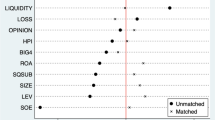Abstract
This paper addresses how to allocate audit resources across different auditable units when misstatements may occur in any or all of the units. We consider two benchmark scenarios. In the first, the extent of overstatement affects only the cost of detection, but not the effectiveness of audit inputs in determining the likelihood of detection. In the second, overstatement directly affects the likelihood of detection but not audit cost. In a two location setting, if overstatement affects only audit effectiveness, the realized value at one location has no impact on the reported value at the other. In addition, the auditor allocates an identical amount of audit resources to each location. In contrast, if overstatement affects only audit cost, the agent’s reporting strategy reflects interdependencies between both realized values and audit costs across locations.
Similar content being viewed by others
References
AICPA. (1987)Report of National Commission on Fraudulent Financial Reporting. New York: AICPA.
AICPA. (1988a)Statement on Auditing Standards No. 53: The Auditor’s Responsibility to Detect and Report Errors and Irregularities. New York: AICPA.
AICPA. (1988b)Statement on Auditing Standards No. 56: Analytical Procedures. New York: AICPA.
Albrecht, W., and M. Romney. (1986) “Red-Flagging Management Fraud: A Validation.”Advances in Accounting 3, 323–333.
Anderson, U., and R. Young. (1988) “Internal Audit Planning in an Interactive Environment.”Auditing: A Journal of Practice and Theory 8, 23–42.
Bell, T., W. Knechel, and J. Willingham. (1993) “An Empirical Investigation of the Relationship between Selected Attributes of Accounting Systems and the Incidence of Audit Differences.” Working paper, KPMG Peat Marwick.
Bell, T., S. Szykowny, and J. Willingham. (1993) “Assessing the Likelihood of Fraudulent Financial Reporting: A Cascaded Logit Approach.” Working paper, KPMG Peat Marwick.
Bloomfield, R. (1995) “Strategic Dependence and Inherent Risk Assessments.”The Accounting Review 70, 71–90.
Fellingham, J., and P. Newman. (1985) “Strategic Considerations in Auditing.”The Accounting Review 60, 639–650.
Finley, D. (1989) “Decision Theory Analysis of Audit Discovery Sampling.”Contemporary Accounting Research 5, 692–719.
Hansen, S. (1991) “Strategic Testing and an Employee’s Span of Action.” Working paper, Stanford University.
Hansen, S. (1993) “Strategic Sampling: Physical Units Sampling, and Dollar Unit Sampling.”The Accounting Review 68, 323–345.
Hansen, S., and J. Watts. (1993) “Report Management and the Independent Auditor’s Reliance on Management’s Report.” Working paper, Stanford University.
Institute of Internal Auditors. (1992)Statement on Internal Auditing Standards No. 8: Analytical Auditing Procedures. New York: Institute of Internal Auditors.
KPMG Peat Marwick. (1993)Fraud Survey Results 1993. New York: KPMG Peat Marwick.
Loebbecke, J., M. Eining, and J. Willingham. (1989) “Auditor’s Experience with Material Irregularities: Frequency, Nature and Detectability.”Auditing: A Journal of Practice & Theory 9, 1–28.
Matsumura, E., and R. Tucker. (1992) “Fraud Detection: A Theoretical Foundation.”The Accounting Review 67, 753–782.
Menzefricke, U. (1983) “On Sampling Plan Selection with Dollar Unit Sampling.”Journal of Accounting Research 21, 96–105.
Morton, S. (1993) “Strategic Auditing for Fraud.”The Accounting Review 68, 825–839.
Newman, P., and J. Noel. (1989) “Error Rates, Detection Rates, and Payoff Functions in Auditing.”Auditing: A Journal of Practice and Theory 8 Supplement, 50–63.
Newman, P., J. Park, and R. Smith. (1996) “Allocating Audit Resource to Minimize Detection Risk due to Theft.” Working paper, University of Texas.
Noel, J., and E. Patterson. (1993). “The Auditor’s Dilemma in Examining Accounts for both Fraud and Defalcation,” Working paper, University of Michigan.
Patterson, E. (1993) “Strategic Sample Size Choice in Auditing.”Journal of Accounting Research 31, 272–293.
Pincus, K. (1989) “The Efficacy of a Red Flags Questionnaire for Assessing the Possibility of Fraud.”Accounting, Organizations and Society 14, 153–163.
Reinganum, J., and L. Wilde. (1986) “Equilibrium Verification and Reporting Policies in a Model of Tax Compliance.”International Economic Review 27, 739–760.
Shibano, T. (1990) “Assessing Audit Risk from Errors and Irregularities.”Journal of Accounting Research 28 Supplement, 110–147.
Wall Street Journal. (1992) “Phar-Mor’s Profit Growth Since 1989 May Have Been Inflated, Sources Say.” August 28, A3.
Author information
Authors and Affiliations
Rights and permissions
About this article
Cite this article
Newman, P., Rhoades, S. & Smith, R. Allocating audit resources to detect fraud. Rev Acc Stud 1, 161–182 (1996). https://doi.org/10.1007/BF02918230
Issue Date:
DOI: https://doi.org/10.1007/BF02918230




